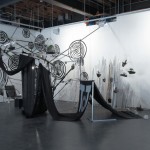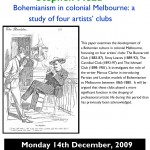Applications now open www.melbourneartjournal.unimelb.edu.au/E-MAJ Masters and Art History PhD candidates are encouraged to apply Deadline: 15 April 2021 emaj (electronic Melbourne art journal) is the only online, refereed art history journal published in Australia. emaj aims to provide an international forum for the publication of original academic research in all areas and periods of art history. emaj welcomes monographic articles about specific artists or art collectives as well as thematic or theoretical analyses on aspects of art history. emaj is published annually by the Fine Arts Network and is edited by art history graduates and post-graduates from the University of Melbourne. Our aim for the position of Sub-Editor is to provide an emerging editor / art historian with the opportunity to expand their editorial skills and professional development in the production of a high quality, online, academic publication. The Sub-Editor…
Category: Melbourne Events
Art and Art History related events in Melbourne. We welcome submissions in this category. If you are organising or know of an event that would be of interest to our readers please see ‘Contact Us’ for detail on how to submit an item.
Dr Michael Brand – ‘Curating for the Common Good’
Dr Michael Brand, Director J. Paul Getty Museum 2005-2010, Miegunyah Distinguished Visiting Fellow. Curating for the Common Good Friday 12 March, 2010, 5.30-6.45 pm, Elisabeth Murdoch Lecture Theatre, University of Melbourne, Parkville. Curatorship straddles the middle ground between art collections placed on display for the public good and the discipline of art history that provides most of the tools for investigating the ideas and ideals that those works of art embody. Drawing upon experience as a curator in Australia and as a museum director in the United States, this lecture will look at issues confronting the practice of curatorship on both sides of the Pacific. Dr Brand’s lecture is the keynote address for the symposium, Interrogating Art Curatorship in Australia, which is being held on 13-14 March to celebrate twenty years of teaching art curatorship at the University of Melbourne.…
Symposium – Interrogating Art Curatorship in Australia (University of Melbourne, Parkville)

An international conference to be held at the University of Melbourne on 12 (evening), 13 and 14 March 2010, interrogating the practice of art curatorship in Australia now, and in the recent past. The program is conceived in celebration of twenty years of art curatorship at the University of Melbourne. It has been organized in conjunction with the launch of the initiative to establish the Australian Institute of Art History at the University of Melbourne. Keynote speaker Michael Brand, Director, J. Paul Getty Museum, 2005-2010 Miegunyah Visiting Fellow, 2010. Symposium speakers include: Anthony Bond; Joanna Bosse; Jane Clark; Alison Carroll; Rebecca Coates; Charlotte Day; Max Delany; David Elliott; Juliana Engberg; Stephen Gilchrist; Alexi Glass-Kantor; Charles Green; Alison Inglis; Jeff Kahn; Rachel Kent; Frances Lindsay; Ruth McDougall; Kyla McFarlane; Christopher Marshall; Hannah Matthews; Karen Quinlan; Patrick Pound; Jason Smith; Daniel Thomas…
‘Garters and Petticoats’: Winterhalter’s 1843 Portraits of Victoria and Albert
The Early Modern Visual Culture Seminar returns for 2010. Eugene Barilo von Reisberg ‘Garters and Petticoats’: Winterhalter’s 1843 Portraits of Victoria and Albert What does official royal iconography tell us? What messages does it communicate about the sitters – and from the sitters? This paper deconstructs two official portraits of Queen Victoria and Prince Albert painted by Franz Xaver Winterhalter (1805-1873) in 1843. It outlines the complex semantic layering within this pair of British royal portraits, and explores in particular the emphasis on Prince Albert’s newly-acquired ‘Englishness’ and the notion of an iconographic ‘gender reversal’ within the context of traditional marital pendants. March 8 2010 6.30pm Room 150 Elisabeth Murdoch Building, Parkville Campus All Welcome Please RSVP Mark Shepheard (shepm@unimelb.edu.au) if you plan to join us for dinner in Lygon Street afterwards. For further details on Eugene’s research on Winterhalter please visit his website…
Anthony d’Offay talk at NGV International
Anthony d’Offay is here in Melbourne in association with the forthcoming Ron Mueck exhibition (22 January – 18 April 2010, NGV) and will present on the ARTIST ROOMS project. For more than 40 years Anthony d’Offay has been one of the world’s leading art dealers and is recognized as one of Britain’s most generous philanthropists. He began dealing in contemporary art in the late 1960s and moved his ground breaking gallery into its Dering Street premises in 1969. ARTIST ROOMS is a new collection of international contemporary art which has been created through one of the largest and most imaginative gifts of art ever made to museums in Britain. The gift has been made by Anthony d’Offay, with the assistance of the National Heritage Memorial Fund (NHMF), The Art Fund and the Scottish and British Governments. ARTIST ROOMS will be…
Launch of emaj issue 4, 2009
The emaj editors invite you all to join us to celebrate the launch of emaj issue 4. Launch of emaj issue 4, 2009 Drinks in the courtyard, Elisabeth Murdoch Building University of Melbourne, Parkville Tuesday December 15, 6-8pm All welcome! Please join us for drinks to celebrate the launch of our 2009 edition! emaj (electronic Melbourne art journal) is the only online, refereed art history journal published in Australia. Founded in 2005, emaj aims to provide an international forum for the publication of original academic research by emerging and established scholars in all areas and periods of art history. All Welcome. If you are on Facebook you can see the event here and to be informed of future issues and calls for papers become a fan of emaj here. www.melbourneartjournal.unimelb.edu/E-MAJ
Stephen Mead – Bohemianism in colonial Melbourne: a study of four artists’ clubs

Stephen Mead Bohemianism in colonial Melbourne: a study of four artists’ clubs This paper examines the development of a Bohemian culture in colonial Melbourne, focussing on four artists’ clubs: The Buonarotti Club (1883-87), Stray Leaves (1889-92), The Cannibal Club (1893-97) and The Ishmael Club (1898-1901). It investigates the role of the writer Marcus Clarke in introducing Parisian and London models of Bohemianism to Melbourne between 1865-1880. It will be argued that these clubs played a more significant function in the shaping of professional artistic life during this period than has previously been acknowledged. Monday December 14th, 2009 Room 148, Elizabeth Murdoch Building, Parkville Campus 6:30-7pm EVCS Christmas Drinks. Paper from 7pm. Dinner afterwards. ALL WELCOME. Please RSVP for dinner to Mark Shepheard, shepm@unimelb.edu.au
Amelia Douglas ‘Pierre Huyghe’ – FAN postdoctoral lecture.
Amelia Douglas Recipient of the 2009 Chancellor’s Prize for Excellence in the PhD, University of Melbourne Pierre Huyghe and the Association of Freed Time What is at stake in the making and recording of history, and what does it mean for a contemporary artist to work as an historiographer? The contemporary French artist Pierre Huyghe is well-known for his multi-faceted works that operate in the gaps between history and story. In this lecture, Huyghe’s practice is shown to facilitate a new model of contemporary history. History as a discursive concept is pliable; its meaning shifts depending on contexts. In presenting an historiographic reading of Huyghe’s practice, this lecture reflects upon how the coalescence of story and history may be a key factor in pulling together the diverse strands of Australian and international art histories. Pierre Huyghe is one of the most significant artists of the 21st century. His work –…
Margaret Manion Lecture 2009
Sophie Matthiesson Curator, International Art, National Gallery of Victoria Captive Markets: Artists in Prison in the French Revolution Hundreds of artists found themselves in prison during the French Revolution. While confined surprising numbers resumed painting, sculpting, drawing and even engraving. Few prisons were without some level or artistic production and exchange. Based on unpublished research of French prison archives and prison-made works of art, this lecture addresses some basic questions. Who were the artists, and why were they imprisoned? What did they make and for whom? Using select case studies, this talk will propose some basic categories and functions of the prison-made object and present a model for its interpretation. It will also consider some of the wider implications of this curious and little-known area of cultural production for our understanding of the political prison in France in the period…
Joseph Burke Lecture 2009 – Jason Smith
The Joseph Burke Lecture 2009 Jason Smith Director, Heide Museum of Modern Art Dark Theatres and Erotic Intensities: some thoughts on the works of Bacon, Henson, Booth and Boynes This lecture will be a further elaboration of my long standing interest in the humanist foundation of the works of many artists with whose practices I have interacted closely during my career. In this lecture I focus on the works of Francis Bacon, Bill Henson, Peter Booth and Robert Boynes as artists who were and are sensitive barometers of their times. Their works alert us to unpredictable and sometimes dire evolutions in culture by offering us images and ideas that are alternative to the mainstream. In his 1878 treatise Human, All Too Human, Friedrich Nietzsche suggested that if ‘someone doesn’t want to see something, they won’t.’ The works of Bacon, Henson,…
